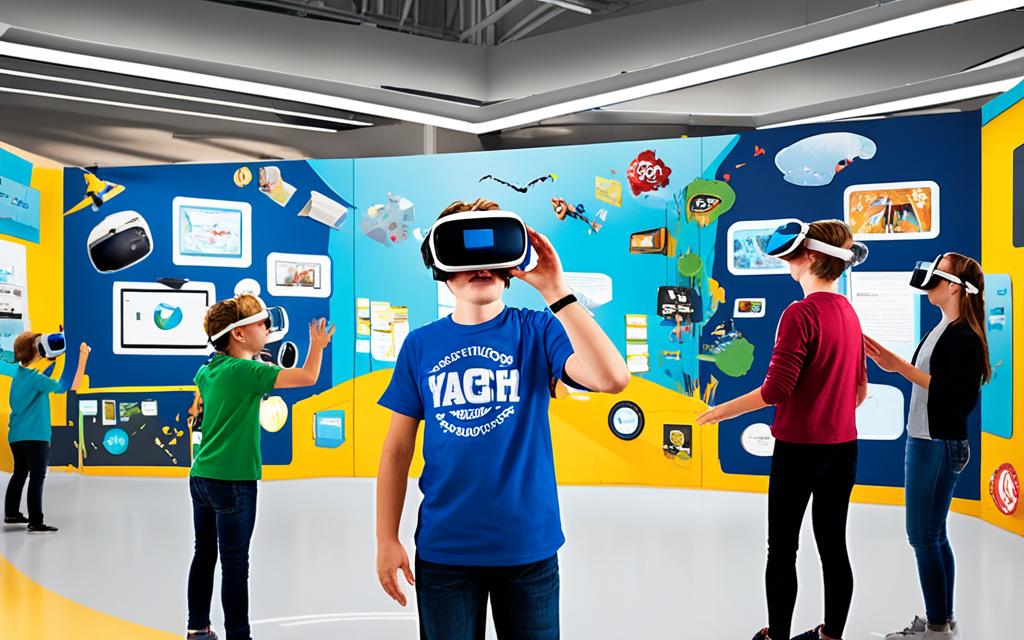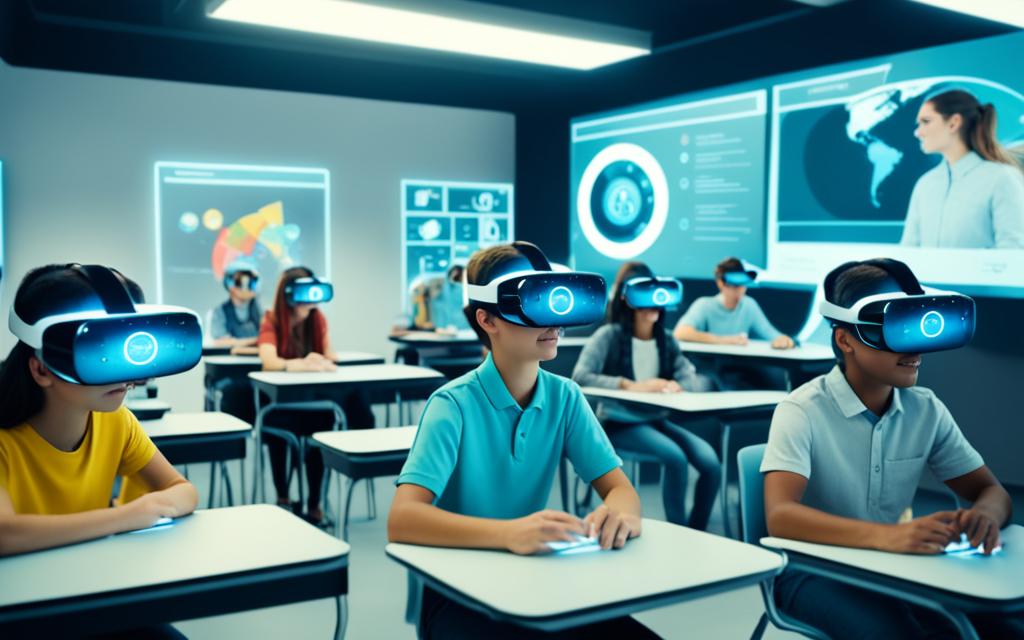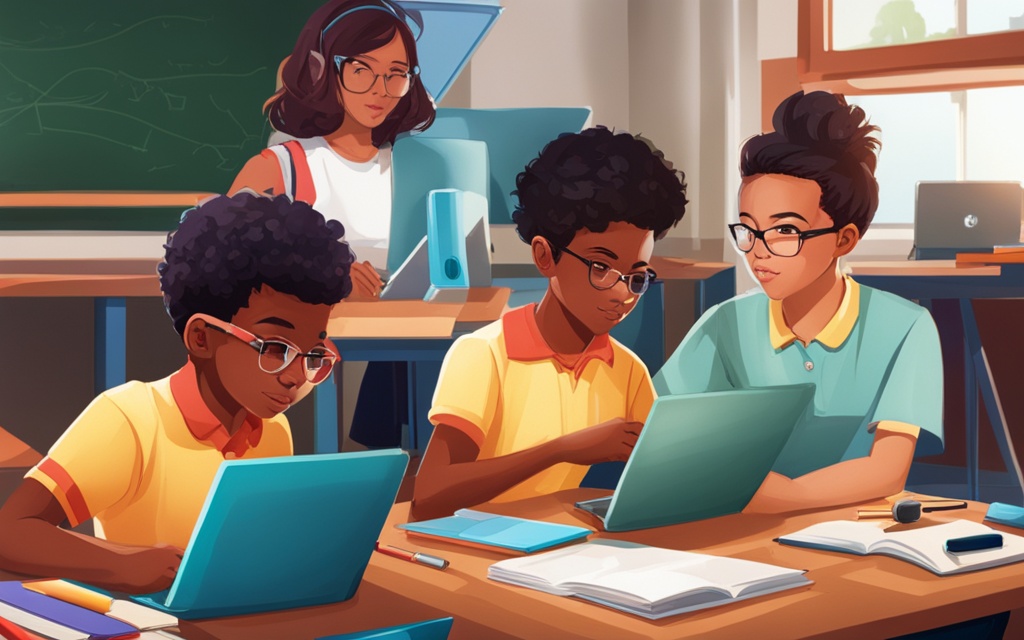Today, schools are filled with cool gadgets. You see smartboards, projectors, mics, and cameras. They help connect students who are learning from home to those in the classroom. There are also systems that send out announcements quickly1 or alert everyone in case of an emergency. But, sometimes these technologies don’t work right. Fixing them can be a hassle and takes time away from teaching.1 If the alert systems fail, it’s not just an annoyance. It could be dangerous during an emergency. That’s why picking the right company to set up these systems is so important.
CTI’s Design Consultants are experts at figuring out what a school needs. They help make a plan and then work with others to put it in action. Their team knows how to install everything properly. They can also help with keeping the systems running smooth by offering maintenance contracts.
Key Takeaways
- Education technology and AV systems are essential in modern classrooms, but troubleshooting and malfunctions can disrupt learning.
- Choosing the right AV integrator is crucial, as they can provide customized solutions and ongoing support.
- Innovative technologies, such as interactive whiteboards, learning analytics, and adaptive learning systems, are transforming the educational experience.
- Leveraging cost-effective and free online resources can engage students and enhance the learning experience.
- Integrating transformative technologies, like collaborative AI and virtual/augmented reality, will continue to shape the future of education.
Transformative Tech Trends in Education
Education is changing fast, thanks to new tech trends. Things like Generative AI and micro-credentials are making learning better. But, the use of mobile devices and smart data is also changing how we learn and teach.
The Rise of Generative AI
Generative AI is making a big impact in education. It has the power to create its own text, images, and videos. This means lessons can be made just for you, helping you learn better and saving teachers time.2
But, many teachers and schools are still unsure about using these new tools. They worry about how to use them safely. So, more work is needed to show them the benefits and rules around these tools.2
Emphasis on Micro-Credentials and Job Boards
The job market is changing, and so are the skills we need. That’s why schools are now offering micro-credentials and showing job opportunities. They want to make sure students are ready for work with the right skills and certificates.2
Mobile Learning: Education in the Palm of Your Hand
Everyone has a mobile device, and that’s changing how we learn. Students use phones and tablets for school work. This new way of learning is flexible and can happen anywhere.
Data-Informed Decision Making: Shaping Education with Insights
Now, schools have a lot of data about students. They use this data to make teaching better. From better lessons to using resources well, data helps schools make smart choices that help students succeed.2
Immersive Learning Experiences
Virtual and Augmented Reality in the Classroom
Virtual and Augmented Reality (VR/AR) technologies have changed learning.3 They offer trips to faraway places and let students do detailed simulations. This way, students learn more by being fully involved.3 Especially in science and engineering, this tech makes it easier to understand complex ideas in a hands-on way.3 Dreamscape Learn from Arizona State University is one cool project to check out.
3 PWC found that immersive learning is 4 times quicker than traditional methods.3 Usually, students have to go to places to see things first-hand, but not with VR/AR. This saves time and money.3 Learning this way doesn’t just teach – it makes students remember more and feel ready to use what they’ve learned.
3 Immersive learning turns watching into doing, making learning fun and active.3 It creates a safe space where learners can tackle lessons at their own speed.3 Plus, AI chatbots make learning personal and engaging, so students enjoy it and remember more.
4 There’s an increasing need for workers to keep learning (according to WEF).4 Companies believe that immersive learning can fill skill gaps.4 It’s been shown that when students are deeply involved, they do better. So, schools are using immersive tech to boost how students learn.
4 In job training, VR helps people make decisions by simulating real-world challenges.4 It’s a big part of immersive learning, creating environments that react to what people do.

Collaborative Digital Presentations
Kate Summers, an educator, involves her students in teaching chemistry concepts to each other. They make online demos using tools like Google Docs and PowerPoint.5 This method boosts students’ skills in presenting and working together.5
Classes that use presentation tools do better than those with only laptops or tablets.5 Also, sometimes, working together in bursts is more helpful than doing it all the time. This can lead to more creative solutions and boost innovation.5
Today, teachers use more tech to make learning a group thing. They use systems and tools that let everyone share their work easily.5 This way of learning helps students communicate better, become leaders, manage their time, and remember what they learn. It also brings them closer to their teachers, exposes them to new thoughts, and gets them ready for life after school.5
When teachers pick the right tech and use it well, students learn more by taking an active part in group activities.5
Many new tools online help people work together easily. For making things and sharing them, we have G Suite, Microsoft 365, and more.6 When people need to do bigger projects, there are tools like Slack and Zoom for online teamwork.6
Platforms such as Microsoft Classroom and Google Classroom make it easier for students to work together with their teacher.6 These digital helpers also teach students ways to be better at working with others, a skill known as social-emotional learning.6
Teachers have lots of tools now to make learning more about teamwork.6 This helps counter the idea that technology can make us feel alone.6
Innovations in Education Technology
Technology in education aims to boost teaching and learning. Tools like e-learning platforms, interactive whiteboards, and7 learning analytics are changing how we learn. They make the classroom experience better for students and teachers.
Big brands like Google and Sony are working on8 Virtual Reality (VR). In education, we see AI grading papers and showing student progress. This makes learning more personal and efficient.
With8 Cloud computing, students can reach resources worldwide. They can submit work from anywhere, too. Besides,8 3D printing is now used to make learning objects that students can touch and explore.
Scanning our faces to enter school? It’s happening, thanks to technological systems. Social media is also bridging the gap between students worldwide. They share ideas and join events easily.
7 Startus Insights show a big rise in companies focused on microlearning. And most educators think AI will change learning a lot in five years. All this tech is shaping a brighter future for education.
9 At the College of Education + Human Development, tech has played a huge role for over a century. A team there leads in developing tech for education across many fields. They’re supported by software experts and marketing professionals.
This team aims to open up university knowledge to everyone. They work with the school’s faculty to create learning platforms. They make and support software that helps people learn better.
One of their products, Flipgrid, wants to make learning better for everyone’s future. It’s just one example of the many tech advances in education.

Gamification and Video Game Development
Gamification is using game mechanics in non-game settings. It’s great for making learning fun and effective. Video game development is a huge part of this. It teaches students skills like team work, critical thinking, and creativity.10 Many teachers are adding elements of game design to their lessons. It’s because they see students are more engaged and learn better this way.10
Teaching Teamwork Through Video Game Creation
A high school teacher, Ben Chun, is doing something special. His students are learning to program and work together by making games for young kids.11 Game-based learning makes the process fun and exciting for students.11 Adding the latest tech, like AI and VR, makes learning through games even more powerful.11 This prepares students for jobs that require strong teamwork skills.
Making learning a game has boosted student interest in many places.10 When students get rewards, like points or badges, they want to do better.10 This is more effective than just studying with books. Each student can learn at their own pace through games.10 Apps like Duolingo and Kahoot! have shown us the benefits of this approach.
11 Game-based learning helps kids focus and keep working on a task longer. It can lead students to earn special certificates when they do well.11 Also, it can strengthen the bond between students and teachers.11 The field of educational technology, or EdTech, is growing fast because of this.11 With more tech, like AI and VR, joining in, the future of EdTech looks bright.11
Differentiated Instruction with Tech Tools
Technology is changing how we teach, making learning more personal for students. Second-grade teacher Robert Pronovost shows us how. He uses tech tools and games to make math lessons fit each student’s style of learning. These tools come from grants and his own efforts.12
Interactive Games for Personalized Learning
Pronovost uses interactive games to make learning personal and fun for his students.13 These tools let students learn at their speed. This way, they understand the math lessons based on what works best for them.13
QR Codes for Differentiation
But that’s not all. Pronovost also uses QR codes for special learning materials. These codes help students find the right resources quickly, letting them learn at their own pace.13 With QR codes, each student gets the help they need, making learning really personal.

Thanks to teachers like Pronovost, classrooms are changing. Students can now learn in ways that suit them best. This mix of tech and teaching is really powerful. It’s making learning a lot better for everyone, and it will keep getting better.
Multimedia Projects and Video Production
High school teacher, Jim Sill, and his students started a media business in Central California. They began with four cameras and computers. Now, they are successful thanks to multimedia projects and video production.14 These projects help students learn important skills. They learn how to communicate well, solve problems, and show their creativity.14
Building Career Skills in Video Class
Media production breaks down into pre, during, and post-production stages. Each stage has its own jobs and needs.14 For video production, students can make various videos. They might film “A Day in the Life,” do career profiles, make documentaries, or create PSA’s.14 When filming in class, it’s important to keep the camera steady. Remember to start talking a few seconds after hitting record. Also, make sure the camera’s microphone is turned on.14
Csikszentmihalyi (2006) argued that creativity is a must-have for everyone. The National Center on Education and the Economy agrees. They say being comfortable with ideas is key in the 21st century.14 Using different media like text, voice, images, and video can improve how students learn.14 Students do best when they use multimedia, simulations, and talk with each other.14
Modern tech, like digital storytelling, helps students tell stories in many classes.14 It mixes tales with multimedia to get students more interested in learning.14
The ISTE-T Standards support using modern tools to enhance learning and creativity.14
Cost-Effective Educational Resources
Today, finding cost-effective education solutions is key for schools and districts. It allows them to offer top-notch learning experiences without going over budget. Take fifth-grade teacher Nicole Dalesio, for instance. She motivates her class by having them make cool projects online using free tech tools.15 Using these affordable or free online tools can spark student interest and improve learning. This is a big help for schools trying to avoid high tech costs.15
Free Online Tools for Student Engagement
Teachers now have access to lots of free tech tools that can make learning fun and engaging16. Platforms like Google Classroom, Moodle, and Khan Academy help create interactive lessons. These lessons keep students interested and make them want to participate.17 By using these low-cost resources, educators can make their classroom a place where students want to learn. It encourages them to work together and do well in their studies.

Conclusion
In the future, transformative technologies will keep growing quickly. Collaborative AI will make learning tailored to each person more common. This includes AI tutors helping students and making teachers’ jobs easier.18
Learning throughout life is becoming more and more important. Platforms for learning are changing to fit what workers need as jobs change.19 Technology is advancing, and teachers will move towards guiding and supporting. Students will have more say in how they learn.20
The future of education and innovations in education technology will be tightly linked. It suggests a future where learning is a lifelong, exciting journey, not just another task.
FAQ
What role does AV integration play in modern schools?
How is Generative AI transforming education?
What are the benefits of Virtual and Augmented Reality in education?
How can collaborative digital presentations enrich student learning?
How are innovations in education technology transforming the classroom?
How can gamification and video game development benefit student learning?
How can technology-based tools support differentiated instruction?
How can multimedia projects and video production develop career skills?
How can cost-effective online resources enhance student engagement?
Source Links
- https://www.edutopia.org/adopt-and-adapt-shaping-tech-for-classroom
- https://www.instructure.com/resources/blog/innovation-unleashed-pivotal-edtech-trends-reshaping-education-2024
- https://musyokac.medium.com/tech-enabled-immersive-learning-what-it-is-and-its-benefits-aea903e57b93
- https://www.magicedtech.com/blogs/an-in-depth-guide-to-immersive-learning-for-education-and-corporate-training/
- https://www.vivi.io/collaboration-as-the-essential-tool-for-educators/
- https://www.gettingsmart.com/2020/01/11/7-ways-tech-supports-collaborative-learning/
- https://meetaverse.com/blog/top-innovations-in-education/
- https://www.theamegroup.com/top-6-technology-innovations-education/
- https://eti.umn.edu/
- https://mdevelopers.com/blog/gamification-in-educational-technology
- https://elearningindustry.com/gamification-in-edtech-the-future-of-innovative-learning
- https://www.edutopia.org/blog/enhanced-learning-through-differentiated-technology-julie-stern
- https://www.ascd.org/el/articles/differentiated-learning-and-technology-a-powerful-combination
- https://open.library.okstate.edu/applicationsofeducationaltechnology/chapter/chapter-12/
- https://medium.com/@galiniostech/education-technology-edtech-development-5cd785eefd4
- https://www.forbes.com/sites/forbestechcouncil/2022/01/24/15-low-cost-high-impact-ways-to-improve-educational-outcomes-through-technology/
- https://www.linkedin.com/advice/1/what-most-cost-effective-ways-integrate-ssnjf
- https://www.thepolicycircle.org/brief/innovation/
- https://www.educause.edu/ecar/research-publications/ecar-study-of-undergraduate-students-and-information-technology/2018/conclusion-and-recommendations
- https://www.eschoolnews.com/it-leadership/2023/12/11/the-impact-of-technology-on-education/
